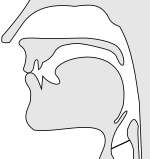Voiceless bilabial nasal
| Voiceless bilabial nasal | |
|---|---|
| m̥ |
The voiceless bilabial nasal is a type of consonantal sound, used in some spoken languages. The symbol in the International Phonetic Alphabet that represents this sound is ⟨m̥⟩, a combination of the letter for the voiced bilabial nasal and a diacritic indicating voicelessness. The equivalent X-SAMPA symbol is m_0.
Features[]

Features of the voiceless bilabial nasal:
- Its manner of articulation is occlusive, which means it is produced by obstructing airflow in the vocal tract. Because the consonant is also nasal, the blocked airflow is redirected through the nose.
- Its place of articulation is bilabial, which means it is articulated with both lips.
- Its phonation is voiceless, which means it is produced without vibrations of the vocal cords.
- It is a nasal consonant, which means air is allowed to escape through the nose, either exclusively (nasal stops) or in addition to through the mouth.
- Because the sound is not produced with airflow over the tongue, the central–lateral dichotomy does not apply.
- The airstream mechanism is pulmonic, which means it is articulated by pushing air solely with the lungs and diaphragm, as in most sounds.
Occurrence[]
| Language | Word | IPA | Meaning | Notes | |
|---|---|---|---|---|---|
| Burmese[1] | မှာ/hma: | [m̥à] | 'notice' | ||
| Central Alaskan Yup'ik[2] | pisteḿun | [ˈpistəm̥un] | 'to the servant' | ||
| Estonian[3] | lehm | [ˈlehm̥] | 'cow' | Word-final allophone of /m/ after /t, s, h/.[3] See Estonian phonology | |
| French | prisme | [pχis̪m̥] | 'prism' | Allophone of /m/. See French phonology | |
| Hmong | Hmoob | [m̥ɔ̃́] | 'Hmong' | ||
| Icelandic | hampur | [ˈham̥pʏr] | 'hemp' | See Icelandic phonology | |
| Jalapa Mazatec[4] | hma | [m̥a] | 'black' | Contrasts with a voiced and a laryngealized bilabial nasal. | |
| Kildin Sami[5] | лēӎӎьк/ljeehmhmk | [lʲeːm̥ʲːk] | 'strap' | ||
| Muscogee | camhcá:ka | [t͡ʃəm̥t͡ʃɑːɡə] | 'bell' | ||
| Ukrainian[6] | ритм/ritm | [rɪt̪m̥] | 'rhythm' | Word-final allophone of /m/ after voiceless consonants.[6] See Ukrainian phonology | |
| Washo | Mášdɨmmi | [ˈm̥aʃdɨmmi] | 'he's hiding' | ||
| Welsh[7] | fy mhen | [və m̥ɛn] | 'my head' | Occurs as the nasal mutation of /p/. See Welsh phonology | |
| Xumi | Lower[8] | [m̥ɛ̃˦] | 'medicine' | Contrasts with the voiced /m/.[8][9] | |
| Upper[9] | |||||
| Yi Language | ꂚ Hma | [m̥a] | 'Cuckoo Tree' | ||
See also[]
Notes[]
- ^ Ladefoged & Maddieson (1996), p. 111.
- ^ Jacobson (1995), p. 3.
- ^ a b Asu & Teras (2009), p. 368.
- ^ Ladefoged & Maddieson (1996), p. 107.
- ^ Kuruch (1985:529)
- ^ a b Danyenko & Vakulenko (1995), p. 6.
- ^ Jones (1984:51)
- ^ a b Chirkova & Chen (2013), pp. 365, 367.
- ^ a b Chirkova, Chen & Kocjančič Antolík (2013), pp. 382–383.
References[]
- Asu, Eva Liina; Teras, Pire (2009), "Estonian", Journal of the International Phonetic Association, 39 (3): 367–372, doi:10.1017/s002510030999017x
- Chirkova, Katia; Chen, Yiya (2013), "Xumi, Part 1: Lower Xumi, the Variety of the Lower and Middle Reaches of the Shuiluo River" (PDF), Journal of the International Phonetic Association, 43 (3): 363–379, doi:10.1017/S0025100313000157[permanent dead link]
- Chirkova, Katia; Chen, Yiya; Kocjančič Antolík, Tanja (2013), "Xumi, Part 2: Upper Xumi, the Variety of the Upper Reaches of the Shuiluo River" (PDF), Journal of the International Phonetic Association, 43 (3): 381–396, doi:10.1017/S0025100313000169[permanent dead link]
- Danyenko, Andrii; Vakulenko, Serhii (1995), Ukrainian, Lincom Europa, ISBN 9783929075083
- Jacobson, Steven (1995), A Practical Grammar of the Central Alaskan Yup'ik Eskimo Language, Fairbanks: Alaska Native Language Center, ISBN 978-1-55500-050-9
- Jones, Glyn E. (1984), "The distinctive vowels and consonants of Welsh", in Martin J. Ball and Glyn E. Jones (ed.), Welsh Phonology: Selected Readings, Cardiff: University of Wales Press, pp. 40–64, ISBN 0-7083-0861-9
- Kuruch, Rimma (1985), Краткий грамматический очерк саамского языка (PDF) (in Russian), Moscow
- Ladefoged, Peter; Maddieson, Ian (1996), The Sounds of the World's Languages, Oxford: Blackwell, ISBN 0-631-19815-6
External links[]
- List of languages with [m̥] on PHOIBLE
Categories:
- Bilabial consonants
- Pulmonic consonants
- Voiceless consonants
- Nasal consonants